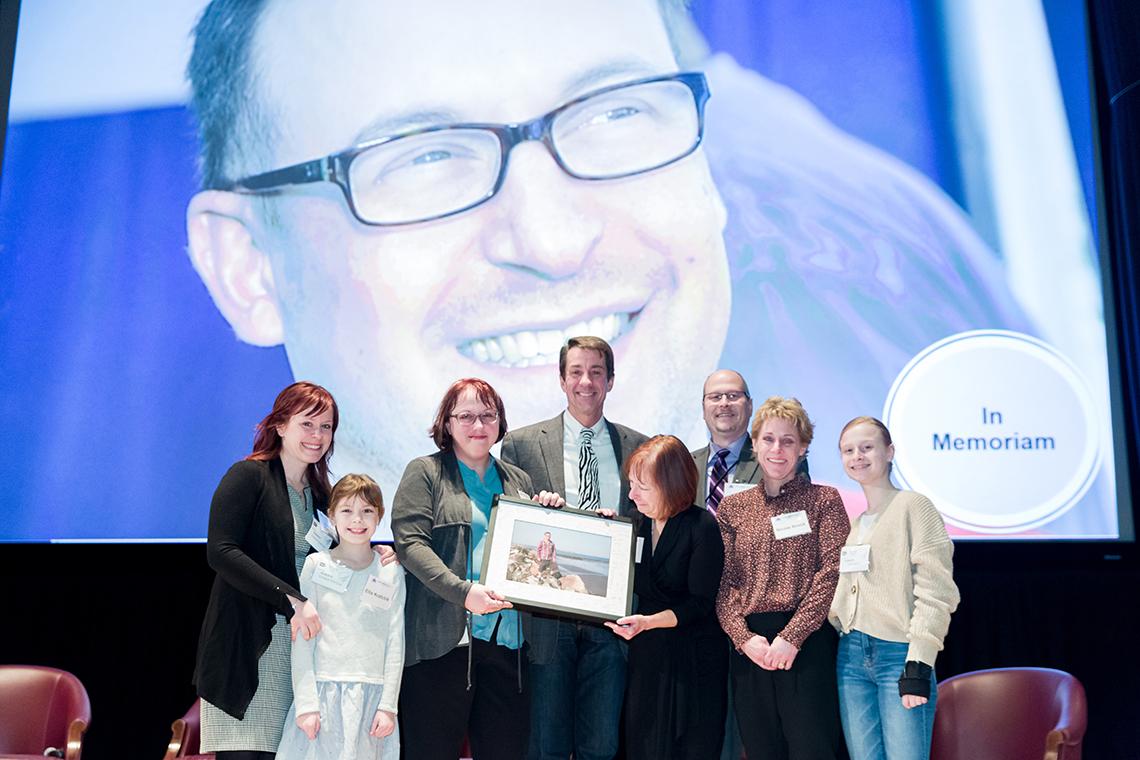NIH Marks 9th Rare Disease Day in New Locale

Photo: Daniel Soñé
If you ever find yourself questioning your vocation as an NIH employee, take in a Rare Disease Day celebration. Like a good Willie Nelson song, NIH’s 9th observance of RDD (it has been marked internationally for 12 years) on Feb. 28 was a mixture of teardrops and laughter as the research community, the patient advocacy community and industry scientists gathered in Natcher Conference Center to inspire one another.
“This is a really, really big day for us,” said NCATS director Dr. Christopher Austin, whose center has housed the Office of Rare Disease Research for the past 5 years. “Rare diseases research is like music—a universal language that transcends disciplines and national boundaries.” A musician himself, Austin announced the theme for the day, which coincides with a new, multi-faceted NIH initiative: “Rare Diseases Are Not Rare!”
The event, traditionally held in the Clinical Center—a major partner in addressing rare diseases, with 552 rare disease research protocols currently underway—moved to Natcher this year to accommodate more than 650 attendees. It opened with video salutations from EURODIS, a rare disease patient advocacy group in Europe, the National Organization for Rare Disorders based in the U.S., as well as from rare disease organizations in Hong Kong, Japan, China, Taiwan, Malaysia, India, Iran, Malta, Spain, Kenya, South Africa, Argentina, Mexico and Canada.
“The medical truth is that rare diseases [of which there are some 7,000], though individually rare, cumulatively affect about 8 percent of the population—about the same as type 2 diabetes,” Austin said, “but with a greater morbidity and mortality, especially among young people. The economic costs, both for direct health care and in lost productivity, are enormous. We need to redefine, in the public’s mind, the importance and impact of rare diseases.”
Clinical Center CEO Dr. James Gilman noted that rare disease studies make up a little over half of the total of patient protocols underway in the CC. “Fifty-seven percent of all Clinical Center patients, or 13,113 people, are enrolled in rare disease research protocols.”
Most are in clinical trials, but some are in so-called natural history studies, known euphemistically, Gilman disclosed, as “admiring the disease.” These protocols involve discovery of the usual course of development of a disease or condition.
The daylong event also included four scientific sessions, poster sessions, award presentations and a display of awareness-raising art.
“Rare Disease Day gets bigger every year,” said NIH director Dr. Francis Collins. “This year is just absolutely amazing. Awareness is steadily growing, certainly at NIH. Most institutes and centers are involved…But we still need to find treatments for most [rare diseases].”

Photo: Daniel Soñé
A few days earlier, Collins and a cadre of IC directors had attended a Capitol Hill reception in support of the Children’s Inn at NIH, where many young patients with rare diseases stay with their loved ones during treatment at the Clinical Center.
“The Congress of the United States is increasingly aware of, and sympathetic to, the need for more resources [for rare disease research],” Collins said. Some 30 members from both parties attended the inn event. “There is a unanimous sense that medical research is important—nobody disagrees—and worthy of support.”
Collins said that when he meets with members of Congress nowadays, he often talks about sickle cell disease, a rare disease affecting some 100,000 people in the U.S. Advances in gene therapy offer fresh promise of not only treating, but perhaps also curing sickle cell disease, he said. [News magazine 60 Minutes featured the work on Mar. 10.]
“This approach could fit other diseases as well,” Collins added. “The excitement of that kind of outcome cannot be overstated.”
The Common Fund—NIH’s “venture capital space”—is becoming involved in in vivo gene editing, Collins continued. “It seems like we’re at a real juncture of opportunity, to go right to the heart of genetic disorders using the CRISPR-Cas system.” Muscular dystrophy might be a good candidate for this type of therapy, he said.
Collins announced that a consortium of 17 academic research institutions receiving $190 million over the next 6 years from NIH has been formed to develop safeguards and standards around therapeutic genome editing. “We’ll be hearing more about that in the next year or two,” he said, noting that the work “does not involve embryos—let’s be clear on that…The work will start in animal models, then hopefully move to patients soon.”

Photo: Daniel Soñé
Collins himself has spent 15 years working on Hutchinson-Gilford progeria syndrome, a research interest that began in the 1980s, when he took care of a patient, Meg Casey, with the disease.
“She was about 3 feet tall and could curse like a sailor,” said Collins. “I remember thinking, ‘I hope someday, some scientist would figure out a way to help her.’”
Later in his career, Collins met another memorable progeria patient, Sam Berns, who was 3 when Collins first saw him. During a span of 14 years before Berns died, researchers learned that progeria, which affects about 200 children in the world, arises when “a simple letter in the DNA code is misspelled—there should be a C instead of a T—in a nuclear structure protein,” Collins said.
Working with the Progeria Research Foundation and Sarepta Therapeutics, Collins and his team think they may be nearing a way to treat progeria successfully. “It’s not out of reach at this point,” he said. “I want this same story of progress to happen for all the conditions you represent,” he told the audience. “You have powerful stories to tell…This is the time, scientifically, to take advantage.”
He left the crowd with the four tenets of Sam Berns’ philosophy: Be okay with what you can’t do, surround yourself with people you like, keep moving forward and never miss a party.
“This is your party today,” Collins concluded.
